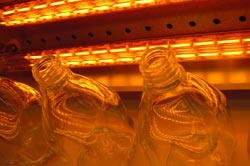Infrared Emitters for Medical Technology

Infrared emitters from Heraeus Noblelight provide effective and high quality drying. In contrast to hot air, infrared heating has a very high heat transfer capacity, which speeds up heating processes. As a result, either the production throughput can be increased or the oven can be reduced in length. Copyright Heraeus Noblelight 2007
However, for some time, infrared emitters have been used directly used to heat tissue before liposuction and they help to remove wrinkles. Infrared emitters are used indirectly in processing medical goods, such as drying granulates, vulcanising tubes or activating adhesives on plasters.
Infrared emitters from Heraeus Noblelight transfer heat without contact and are easy to control. As a result, they can be precisely used in sensitive processes and in clean rooms.
It is already well known that infrared heat dries coatings and heats plastics. And many people still remember the old infrared lamps in bathrooms and in piglet rearing. But applications in medical technology?
Modern infrared emitters offer much more than simply heat. Above all, they transfer energy very precisely and according to the properties of the product and the requirements of the production activity. Modern infrared emitters can be matched exactly to the heating process in terms of wavelength, shape and power and they react to control commands in a matter of seconds. As a result, temperature profiling is possible and difficult process conditions can be precisely adhered to.
A very big advantage of infrared technology is that the energy is transferred by electro-magnetic radiation so that the heat is first generated in the product itself and there is no need for a contact/heat transfer medium such as air or gas. This minimises contamination and facilitates heating applications in clean rooms or under vacuum.
Infrared radiation is already being used directly in the healing of skin complaints, where the skin must be irradiated with radiation of quite precise wavelength. Likewise, creases or skin folds can be removed with specific short wave emitters. Good results are also being achieved in liposuction. Medium wave carbon emitters are used to warm the body fat before it is actually sucked away, providing significantly better results.
Infrared emitters are being used even more increasingly in medical technology in indirect applications. Infrared heat offers contact-free welding of filters and is more cost-effective than ultrasonic welding. Infrared heat also dries coatings or printed lettering on syringes, tubes, bottles or other containers and is used to shrink foil onto tubes. Elastic bandages, gauze, powder and granulates are also efficiently dried and unwanted burrs on injection-moulded plastic materials can be easily melted away and removed.
Another advantage of infrared is that edges, corners and very small areas can be heated in a targeted manner, while the rest of the product or production plant remains comparatively cool. Quartz glass emitters can even be made so that they meet three-dimensional heating requirements.
In contrast to hot air, infrared heat has a very high heat transfer capacity. This speeds up heating processes so that either product through-put can be increased or the oven can be reduced in length.
Heraeus Noblelight offers infrared emitters matched to product and process. More importantly, they also offer customers the opportunity to carry out practical tests on sensitive processes in their own in-house Applications Centre. Tests are carried out by technicians and application specialists and are evaluated, with computer support, with the customer.
Heraeus Noblelight GmbH with its headquarters in Hanau and with subsidiaries in the USA, Great Britain, France, China, Australia and Puerto Rico, is one of the technology- and market-leaders in the production of specialist light sources. In 2006, Heraeus Noblelight had an annual turnover of 88 Million € and employed 651 people worldwide. The organisation develops, manufactures and markets infrared and ultraviolet emitters for applications in industrial manufacture, environmental protection, medicine and cosmetics, research, development and analytical laboratories.
Heraeus, the precious metals and technology group headquartered in Hanau, Germany, is a global, private company in the business segments of precious metals, sensors, dental and medical products, quartz glass and specialty lighting sources. With revenues of more than EUR 10 billion and more than 11,000 employees in over 100 companies, Heraeus has stood out for more than 155 years as one of the world’s leading companies involved in precious metals and materials technology.
Further Information:
Readers:
Heraeus Noblelight GmbH
Reinhard-Heraeus-Ring 7
D-63801 Kleinostheim
phone +49 6181/35-8545, fax +49 6181/35-16 8545
E-Mail hng-infrared@heraeus.com
Press:
Dr. Marie-Luise Bopp
Heraeus Noblelight GmbH,
phone +49 6181/35-8547, fax +49 6181/35-16 8547
E-Mail marie-luise.bopp@heraeus.com
www.heraeus-noblelight.com
Media Contact
More Information:
http://www.heraeus-noblelight.comAll latest news from the category: Medical Engineering
The development of medical equipment, products and technical procedures is characterized by high research and development costs in a variety of fields related to the study of human medicine.
innovations-report provides informative and stimulating reports and articles on topics ranging from imaging processes, cell and tissue techniques, optical techniques, implants, orthopedic aids, clinical and medical office equipment, dialysis systems and x-ray/radiation monitoring devices to endoscopy, ultrasound, surgical techniques, and dental materials.
Newest articles

First-of-its-kind study uses remote sensing to monitor plastic debris in rivers and lakes
Remote sensing creates a cost-effective solution to monitoring plastic pollution. A first-of-its-kind study from researchers at the University of Minnesota Twin Cities shows how remote sensing can help monitor and…

Laser-based artificial neuron mimics nerve cell functions at lightning speed
With a processing speed a billion times faster than nature, chip-based laser neuron could help advance AI tasks such as pattern recognition and sequence prediction. Researchers have developed a laser-based…

Optimising the processing of plastic waste
Just one look in the yellow bin reveals a colourful jumble of different types of plastic. However, the purer and more uniform plastic waste is, the easier it is to…



